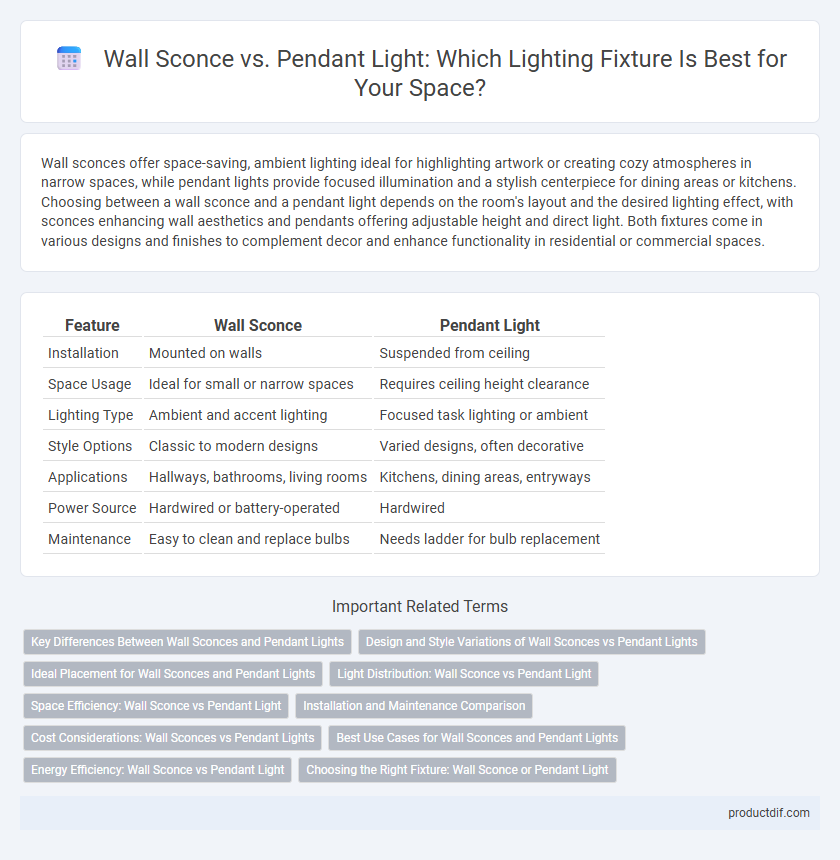Wall sconces offer space-saving, ambient lighting ideal for highlighting artwork or creating cozy atmospheres in narrow spaces, while pendant lights provide focused illumination and a stylish centerpiece for dining areas or kitchens. Choosing between a wall sconce and a pendant light depends on the room's layout and the desired lighting effect, with sconces enhancing wall aesthetics and pendants offering adjustable height and direct light. Both fixtures come in various designs and finishes to complement decor and enhance functionality in residential or commercial spaces.
Table of Comparison
| Feature | Wall Sconce | Pendant Light |
|---|---|---|
| Installation | Mounted on walls | Suspended from ceiling |
| Space Usage | Ideal for small or narrow spaces | Requires ceiling height clearance |
| Lighting Type | Ambient and accent lighting | Focused task lighting or ambient |
| Style Options | Classic to modern designs | Varied designs, often decorative |
| Applications | Hallways, bathrooms, living rooms | Kitchens, dining areas, entryways |
| Power Source | Hardwired or battery-operated | Hardwired |
| Maintenance | Easy to clean and replace bulbs | Needs ladder for bulb replacement |
Key Differences Between Wall Sconces and Pendant Lights
Wall sconces are mounted directly on walls, offering ambient or accent lighting while saving floor space, whereas pendant lights hang from the ceiling, providing focused illumination typically used for task or general lighting. Wall sconces often feature smaller fixtures and are ideal for narrow spaces or hallways, while pendant lights come in various sizes and styles, making them a focal point in dining areas or kitchens. The key differences lie in their installation location, light distribution, and design impact on interior aesthetics.
Design and Style Variations of Wall Sconces vs Pendant Lights
Wall sconces offer a wide range of design and style variations, from minimalist modern shapes to ornate vintage patterns, making them versatile for accentuating walls and creating ambient lighting. Pendant lights provide bold visual impact with diverse options like industrial metal designs, glass globes, and fabric-covered fixtures, ideal for statement pieces or task lighting over dining areas. Both lighting fixtures enhance interior aesthetics, but wall sconces tend to blend seamlessly into wall architecture while pendant lights become central focal points.
Ideal Placement for Wall Sconces and Pendant Lights
Wall sconces are ideally placed along hallways, beside mirrors, or flanking artwork to provide ambient or accent lighting without occupying floor space. Pendant lights work best over dining tables, kitchen islands, or entryways where focused downward illumination enhances functionality and adds a decorative element. Choosing between wall sconces and pendant lights depends on room layout, ceiling height, and desired light coverage.
Light Distribution: Wall Sconce vs Pendant Light
Wall sconces typically provide focused or ambient lighting by casting light upward, downward, or both, enhancing wall surfaces and creating accent lighting in hallways or living spaces. Pendant lights offer more versatile light distribution, often emitting direct, task-oriented illumination downward while also dispersing ambient light throughout a room, making them ideal for kitchens and dining areas. The choice between wall sconce and pendant light hinges on desired light coverage, with sconces excelling in wall accentuation and pendants delivering broader or focused room lighting.
Space Efficiency: Wall Sconce vs Pendant Light
Wall sconces maximize space efficiency by mounting directly on walls, freeing up floor and table areas, ideal for small or narrow rooms. Pendant lights require ceiling clearance and can dominate vertical space, making them less suitable for compact spaces. Choosing wall sconces enhances room openness while providing focused illumination without occupying valuable surface or floor space.
Installation and Maintenance Comparison
Wall sconces offer simpler installation as they mount directly on walls, requiring only electrical wiring within the wall cavity, making them ideal for limited ceiling access. Pendant lights demand secure ceiling mounts and often need reinforced support due to their weight and hanging design, which can complicate installation. Maintenance for wall sconces typically involves easy bulb replacement and occasional cleaning, while pendant lights may require ladder access for bulb changes and more effort to clean the fixture's surfaces and suspended components.
Cost Considerations: Wall Sconces vs Pendant Lights
Wall sconces typically cost less upfront and require minimal installation expenses since they mount directly on walls, making them a budget-friendly option for accent lighting. Pendant lights often involve higher costs due to more complex wiring, ceiling reinforcement, and professional installation, suitable for statement or task lighting in larger spaces. Choosing between the two depends on project budget constraints and the desired layered lighting effect.
Best Use Cases for Wall Sconces and Pendant Lights
Wall sconces are ideal for accent lighting in narrow hallways, bathroom vanities, and creating ambiance along staircases due to their space-saving design and directional illumination. Pendant lights excel in task lighting above kitchen islands, dining tables, and entryways, providing focused light while serving as a decorative centerpiece. Choosing between wall sconces and pendant lights depends on the desired lighting effect, available space, and functional requirements of the room.
Energy Efficiency: Wall Sconce vs Pendant Light
Wall sconces generally consume less energy due to their smaller bulbs and targeted illumination, making them ideal for accent lighting and reducing overall power usage. Pendant lights often use larger or multiple bulbs to provide broader light coverage, which can increase energy consumption if not equipped with energy-efficient LED bulbs. Selecting LED technology for either fixture maximizes energy efficiency, while dimmable options enhance control over electricity use and light output.
Choosing the Right Fixture: Wall Sconce or Pendant Light
Wall sconces provide ambient or task lighting while saving floor space, ideal for hallways or beside mirrors, enhancing wall aesthetics with decorative appeal. Pendant lights offer focused illumination suitable for dining areas or kitchen islands, creating visual interest through adjustable heights and diverse designs. Selecting between a wall sconce and pendant light depends on room size, desired light intensity, and functional versus decorative priorities for optimal lighting performance.
Wall sconce vs Pendant light Infographic

 productdif.com
productdif.com